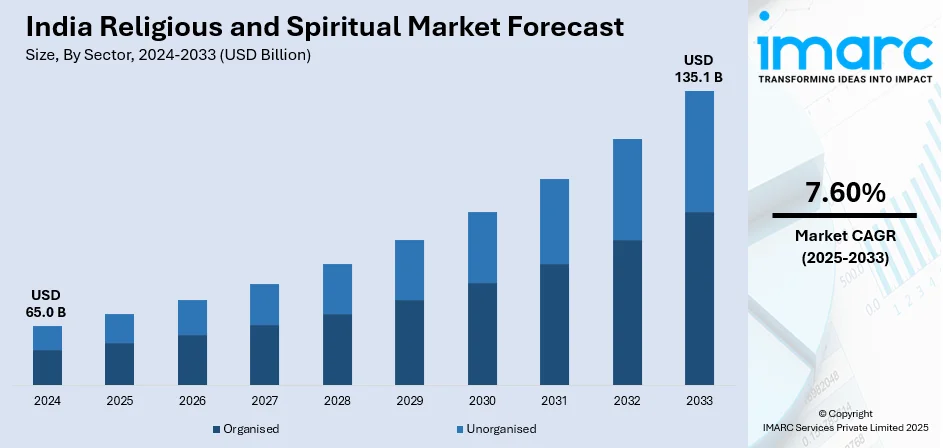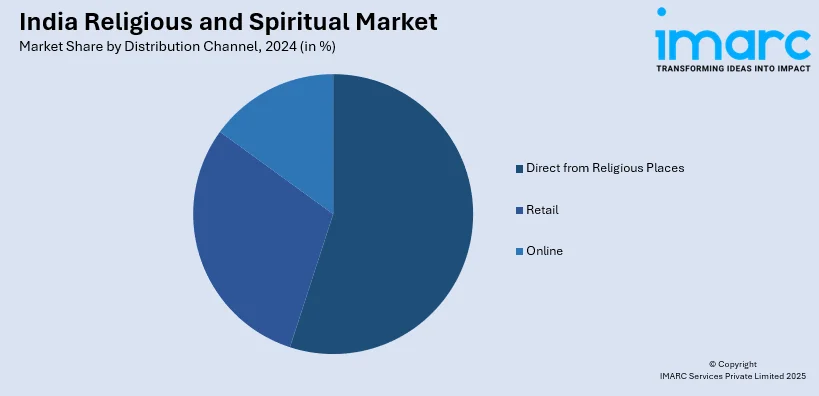
India Religious and Spiritual Market Size, Share, Trends and Forecast by Sector, Income Source, Distribution Channel, Religion, and Region, 2025-2033
India Religious and Spiritual Market Summary:
The India religious and spiritual market size reached USD 65.0 Billion in 2024 and is projected to reach USD 135.1 Billion by 2033, growing at a CAGR of 7.60% during 2025-2033. The market's growth is attributed to increasing pilgrimage tourism, rising demand for spiritual products and services, government support for religious infrastructure, and the rise of digital and personalized religious platforms.
Market Insights:
- On the basis of sector, the market has been divided into organised and unorganised.
- On the basis of income source, the market has been divided into religious tourism, donations, media and music, religious items and merchandise, construction and infrastructure, and others.
- On the basis of distribution channel, the market has been divided into direct from religious places, retail, and online.
- On the basis of religion, the market has been divided into Hinduism, Islam, Sikhism, Buddhism, Christianity, and others.
- On the basis of region, the market has been divided into North India, West and Central India, South India, and East India.
Market Size and Forecast:
- 2024 Market Size: USD 65.0 Billion
- 2033 Projected Market Size: USD 135.1 Billion
- CAGR (2025–2033): 7.60%
Religion can be defined as an organized belief system consisting of practices related to the worship of a single or multiple supernatural forces. Some of the commonly practiced religious and spiritual beliefs in India include Hinduism, Islam, Sikhism, Buddhism and Christianity. They involve various beliefs, worldviews, texts, revelations, morals and prophecies that portray sacred significance to the members of a particular faith. Individuals also practice sermons, rituals, prayers, meditation and feasts as per their devotion to religious faith. On the other hand, spirituality is an overlapping concept that involves practices and beliefs around the value, connection and meaning of the existence of an individual. It is usually practiced to achieve a positive state of mind with contentment, acceptance and gratitude. Individuals indulge in religious and spiritual tourism, donation drives, books and literature tools, flowers, garlands, candles and incense sticks to practice and propagate their beliefs.

To get more information on this market, Request Sample
The India religious and spiritual market share is primarily augmented by the increasing pilgrimage tourism across the country. The Government of India is launching various initiatives and projects, such as pilgrimage rejuvenation and spirituality, heritage augmentation drive (PRASHAD) and heritage city development as well as augmentation yojana, for promoting the infrastructural development at various heritage sites. These policies aim to provide adequate resources for effective rail, road and water transport systems, network connectivity, information centers, drinking water and renewable power for the enhanced convenience of pilgrims and tourists. According to the India religious and spiritual market analysis, the increasing consumer preference for incense-based products for religious, spiritual and meditational purposes is also contributing to the growth of the market. Temples, churches and other religious establishments widely use products, such as agarbatti, dhoop and candles, for their daily spiritual and religious regimes. Other factors, including the advent of virtual reality (VR) kiosks to provide an immersive and interactive experience of religious sites to the devotees, are anticipated to drive the market toward growth.
India Religious and Spiritual Market Trends:
Digital Spirituality, Convenience, and Personalization
India’s religious and spiritual sector is undergoing a rapid tech-driven shift with the emergence of spiritual tech platforms and faith-tech startups offering services like online pujas, astrology consultations, virtual satsangs, and guided meditations. These services are now integrated with quick commerce models, enabling doorstep delivery of samagri, prasad, idols, and ritual kits within hours. The demand for personalized spiritual experiences, curated rituals based on nakshatra, location, or family traditions, is also gaining traction, especially among younger urban audiences. This digital movement is being fueled by rising smartphone penetration, comfort with online transactions, and growing interest in spiritual wellness to carer to the India religious and spiritual market demand. However, the market still faces challenges around trust, standardization, and lack of regulatory oversight. Fragmentation among service providers and varied pricing also create friction for consumers. Despite these gaps, the momentum is strong, with venture-backed platforms working to organize a largely unorganized space, making spirituality more accessible, structured, and on-demand for millions across income brackets and regions.
Experiential Tourism, Branding, and Sustainability
Pilgrimage tourism continues to dominate the religious economy, with places like Varanasi, Tirupati, and Shirdi drawing millions annually. At the same time, India is witnessing a rise in wellness tourism, where spiritual retreats, yoga centers, and holistic healing resorts attract both domestic and international travelers seeking mental clarity and peace. Consumers are also becoming more conscious, creating new demand for sustainable religious products like eco-friendly idols, soy-based candles, recycled paper scriptures, and biodegradable offerings. Celebrity-led temple visits, endorsements, and partnerships with wellness brands are making spirituality more aspirational and widely visible. The government’s support, through schemes like PRASHAD and HRIDAY, has helped build modern infrastructure at key religious destinations, unlocking large-scale investment and India religious and spiritual market growth. This has created strong opportunities for brands to cater to a spiritually motivated consumer base that values convenience, experience, and ethical choices. Blending tradition with lifestyle, the sector is expanding beyond faith into travel, wellness, retail, and popular culture.
India Religious and Spiritual Industry Segmentation:
IMARC Group provides an analysis of the key trends in each sub-segment of the India religious and spiritual market report, along with forecasts at the country and regional level from 2025-2033. Our report has categorized the market based on sector, income source, distribution channel and religion.
Breakup by Sector:
- Organised
- Unorganised
Breakup by Income Source:
- Religious Tourism
- Donations
- Media and Music
- Religious Items and Merchandise
- Construction and Infrastructure
- Others
Breakup by Distribution Channel:

- Direct from Religious Places
- Retail
- Online
Breakup by Religion:
- Hinduism
- Islam
- Sikhism
- Buddhism
- Christianity
- Others
Breakup by Region:
- North India
- West and Central India
- South India
- East India
Competitive Landscape:
The competitive landscape of the industry has also been examined along with the profiles of the key players.
Latest News and Developments:
- Ujjain hosted the Spiritual & Wellness Summit in June 2025, bringing together spiritual leaders, wellness experts, and policymakers to explore the integration of traditional health systems with modern wellness innovations. The summit featured key panel discussions on developing collaborative wellness frameworks and building a sustainable wellness ecosystem in India.
- On May 20, 2025, the Uttar Pradesh government announced an investment of INR 4,560 Crore (USD 547 Million) to upgrade road infrastructure connecting major religious and spiritual destinations across the state. The initiative covers 272 projects aimed at improving travel to sites like Ayodhya, Varanasi, and Mathura, focusing on widening roads, traffic safety, and beautification to enhance pilgrim experience through better connectivity.
- On April 10, 2025, Pujashree Products Global Pvt Ltd raised INR 12 Crore (USD 1.5 Million) in seed capital to redefine spiritual consumption in India. The company, which aims for a revenue target of INR 100 Crore (USD 12 Million) in its first financial year, offers high-quality, Shastra-compliant puja kits and ritual products available through both online platforms and select physical stores.
- It was announced in February 2025 that around 32 lakh temples, primarily in India and valued at INR 6 Lakh Crore (USD 72 Billion), will come under a single federation to boost religious tourism and modernize temple management. The initiative will launch at ITCX 2025 in Tirupati, hosting 2,000 institutions from 58 countries, 111+ speakers, 15 workshops, and 60+ expo stalls. With support from India's Ministry of Tourism and Culture, the summit will focus on digitization, AI integration, sustainable practices, and expanding community services in temple ecosystems.
- On January 22, 2025, Online Chikitsa Mitra (OCM) partnered with the Uttar Pradesh government to provide healthcare services at Mahakumbh 2025, the world’s largest religious gathering, expected to draw 400 million Hindu pilgrims over six weeks, making it the world’s largest religious gathering. Through this collaboration, OCM operated a telehealth outpatient department (OPD) offering free online consultations to over 40 Crore pilgrims, with services running daily from 8 a.m. to 8 p.m. The initiative emphasizes the integration of technology to enhance accessibility and quality healthcare at large-scale public events, supporting the Uttar Pradesh government's Digital Mahakumbh initiative.
Report Coverage:
| Report Features | Details |
|---|---|
| Base Year of the Analysis | 2024 |
| Historical Period | 2019-2024 |
| Forecast Period | 2025-2033 |
| Units | Billion USD |
| Segment Coverage | Sector, Income Source, Distribution Channel, Religion, Region |
| Region Covered | North India, West and Central India, South India, East India |
| Customization Scope | 10% Free Customization |
| Post-Sale Analyst Support | 10-12 Weeks |
| Delivery Format | PDF and Excel through Email (We can also provide the editable version of the report in PPT/Word format on special request) |
Key Questions Answered in This Report
The religious and spiritual market in India was valued at USD 65.0 Billion in 2024.
The India religious and spiritual market is projected to exhibit a CAGR of 7.60% during 2025-2033, reaching a value of USD 135.1 Billion by 2033.
The India religious and spiritual market is driven by rising spiritual consciousness, increasing disposable incomes, and a growing demand for personalized religious services. Digitalization of rituals and puja offerings, popularity of spiritual tourism, and the proliferation of online platforms further fuel market growth. Additionally, support from government initiatives and widespread cultural traditions sustain long-term consumer engagement and sector expansion.
Need more help?
- Speak to our experienced analysts for insights on the current market scenarios.
- Include additional segments and countries to customize the report as per your requirement.
- Gain an unparalleled competitive advantage in your domain by understanding how to utilize the report and positively impacting your operations and revenue.
- For further assistance, please connect with our analysts.
 Request Customization
Request Customization
 Speak to an Analyst
Speak to an Analyst
 Request Brochure
Request Brochure
 Inquire Before Buying
Inquire Before Buying




.webp)




.webp)












